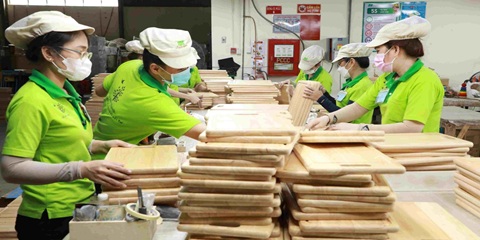Want to be in the loop?
subscribe to
our notification
Business News
GARMENT FIRMS SHOULD MEET WORKERS’ NEEDS
Garment and textile firms should understand the needs of their workers and invest in enhancing human resource management to sustain a productive and quality workforce, a seminar heard in HCM City last Saturday.
Pham Xuan Hong, chairman of the HCM City Association of Garment, Textile, Embroidery and Knitting, told the “Develop high quality garment and textile workforce in the context of international business integration” seminar that building a skilled and “high-quality” workforce has always been a major focus for the garment and textile industry.
It is becoming an increasingly important factor since Viet Nam is acceding to many international trade agreements and has to compete with other countries.
According to the 2017 Better Work report published by the International Labour Office and International Finance Corporation, Viet Nam is the fifth largest garment and textile supplier in the world and second largest to the US.
Last year its exports were worth US$34 billion and they are expected to reach $35 billion this year.
According to Dr Pham Xuan Thu, who has done a lot of research on the industry, though the exports are huge the value addition is growing at a very slow pace.
To bolster competition and add more value to Vietnamese garment and textile products, the industry should improve the quality of its workforce, he said.
Also according to the report, the garment sector is the largest formal employer in the country, providing jobs to more than 2.5 million people.
Thu said most garment and textile workers are young, with about 80 per cent of them being under 30, physically fit for the job and very hard-working.
Besides, the rate of workers with technical skills in the industry is 21.1 per cent, which is higher than the average rate of other manufacturing and processing industries, he said. But the industry also faces some challenges such as its productivity, which is lower than the average rate for the country’s industrial sector. With the two of them being VND56 million ($2,460) and VND104.3 million ($4,590) per person per year.
“Though the productivity of major garment firms is much higher than the average rate, Viet Nam has a huge number of small and household garment and textile businesses.”
Another challenge is the high employee turnover rate, he said.
At major garment and textile companies like Nha Be, Viet Tien, and Phong Phu, it is 15-20 per cent.
The number is much higher at small and FDI firms: 20-30 per cent and 30-40 per cent respectively.
Thu said one of the reasons for this is that companies fail to meet the needs of their workers. The monthly salary of a garment worker is around VND4.3 million, which is just enough to cover 75-80 per cent of their basic needs.
“Though the salary has been raised over time there are still companies which fail to pay workers on time, leading to strikes and employees quitting.”
Another reason is that employees tend to switch to other companies to look for better opportunities after getting training and experience, he said. Besides, with the main workforce in the industry being young women emigrant workers, they are highly likely to quit their jobs to marry and return to their hometown after a period of time, he explained.
Source: VIR
Related News

A STELLAR CHRISTMAS AT SOFITEL SAIGON PLAZA
Experience the magic of year-end celebrations in five-star luxury, where Parisian elegance meets Saigon’s festive vibrancy. Discover your Stellar Christmas moments: https://sofitel-saigon-plaza.com/festive-offer-2025

CONSTRUCTION SECTOR POSTS OVER 9% GROWTH IN 2025
Industries under the ministry’s management accounted for an estimated 17.23% of national gross domestic product (GDP), up about 0.17 percentage point from 2024. They contributed around 1.96 percentage points to overall GDP growth, reported the Vietnam News Agency. The contribution helped push Vietnam’s economic growth to above 8% in 2025 and supports the Government’s aim of pursuing double-digit growth in the coming years.

VIETNAM PUTS PUBLIC INVESTMENT DISBURSEMENTS AT VND603.6 TRILLION
Vietnam’s public investment disbursements had amounted to VND603.6 trillion in the year to December 18, equivalent to 66.1% of the plan assigned by the prime minister. According to the Ministry of Finance, actual disbursements by December 11 had totaled VND577.7 trillion, or 63.3% of the prime minister-approved plan of VND913.2 trillion, the Vietnam News Agency reported.

SHINE INTO 2026 AT HOIANA RESORT & GOLF!
This New Year’s Eve, celebrate where the sea meets the sky. Vibrant performances, festive dining, DJ beats, live bands and dazzling fireworks come together for one unforgettable night. From beachfront countdown moments to curated New Year’s Eve dinners across Hoiana, every detail is designed to welcome 2026 in style.

VIETNAM’S TRADE SET TO SURPASS US$900 BILLION FOR FIRST TIME
Vietnam’s total import-export turnover is expected to reach about US$920 billion by the end of the year, marking the first time the country’s trade value has exceeded the US$900-billion mark. As of December 15, Vietnam’s total trade turnover stood at US$883.7 billion, according to the Agency of Foreign Trade under the Ministry of Industry and Trade.

GLOBAL SOURCING FAIR VIETNAM 2026 – THE TRULY GLOBAL B2B SOURCING SHOW IN VIETNAM TO EXPAND & DIVERSIFY YOUR EXPORT MARKETS WORLDWIDE
The 4th edition of Global Sourcing Fair Vietnam returns in 2026 with an impressive scale, featuring 700 booths showcasing Fashion & Accessories, Home & Gifts, and the newly introduced Printing & Packaging Products from 500+ verified suppliers across Vietnam and Asia – including Mainland China, Taiwan, Hong Kong SAR, South Korea, India, Bangladesh, ASEAN, and more.
























